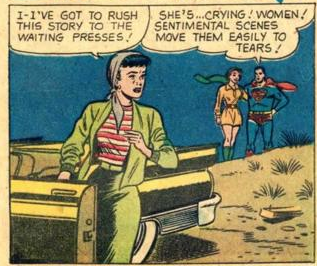Most serious comic book fans know the time between the Golden and Silver ages was a strange era for comics. Wertham's Seduction of the Innocent had left the publishers in an aimless funk, their crime comics cancelled, their superhero books toned down and their business failing.
And with misogynistic writing like that to the right (from Action Comics No. 260, where Superman pretends to have an affair with his disguised 15-year-old cousin Supergirl for a typically convoluted plot reason), who can blame readers for leaving the medium?
While the 1956 introduction of the Silver Age Flash started the industry's revival, 1961's Fantastic Four No. 1 cemented it. But as famous as the FF is, the concepts of scientific adventurers (or, as Mark Waid later called them, "Imaginauts"), was actually predated a few years earlier with DC's Challengers of the Unknown -- not coincidentally co-created by Jack Kirby, who also co-created the Fantastic Four.
The group debuted in Showcase No. 6 (February 1957) as four acquaintances -- Kyle "Ace" Morgan, Matthew "Red" Ryan, Leslie "Rocky" Davis, and Walter Mark "Prof" Haley -- miraculously survived a plane crash unscathed. They concluded that since they were "living on borrowed time," they should band together for hazardous adventures. I recently checked out a collected edition of the Challengers' first stories from a local library, and you can really see the sense of adventuring and exploration (rather than simply fighting bad guys) that was later to be the hallmark of the best early FF stories.
Not to say there weren't some silly moments that marked the Challengers as products of their Cold War, "American Can-do," era. For example, in the panel below, an alien is on the loose and the Challengers are concerned its appearance will harm industrial production:
In another silly panel, the amazing concept of a "rock formation" in a city, is cause for worry:
What city doesn't have a rock formation somewhere? Sigh.
Still the Challengers were good fun in their early appearances, if not up to the amazing standard that the Fantastic Four would set less than five years later.




No comments:
Post a Comment